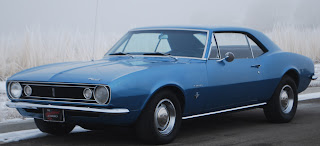Annoyed by this he traveled to the next closest dealership about 30 miles away.
An enthusiastic salesmen greeted him right away. Only problem was they did not have a Camaro that he wanted.
So he decided to wait for his very own special ordered Camaro, and began the ordering process choosing a Nantucket Blue, white interior, 4 barrel 275 HP 327, single exhaust, 4 speed, console, 1967 Camaro.
Later, he made changes to the order adding dual exhaust, posi-traction, and changed the interior color to Black.
During March of 1967 his Camaro was assembled in the Van Nuys California plant. He took delivery of the Camaro April 14, 1967.
February 1971 this man married my Mother still driving the '67 Camaro he had ordered. I was 7 years old.
My biological Father had passed away due to injury's from a car accident he was a passenger in, and my Mother still had his '66 Olds 442.
I remember them trying to decide which car to keep after they bought a new '72 Buick station wagon, not needing 3 cars.
The Camaro got better fuel mileage than the 442, so they kept the Camaro.
Luckily for me when I was in my teens they still had the Camaro.
My Step-Father had a home milk delivery business at the time.
We made a deal that I would work for him during my summer breaks from school for a few years until I had earned enough money to buy the Camaro.
I was 15 when the car was officially paid for.
Part of the deal I made with my Step-Father was that I could not modify it to a point that it could not be restored back to it's original state. Also, I could not install headers, fancy intake manifolds and carbs and no cutting holes in it.
By making this deal he had preserved what is now becoming a collector's dream.
The sleeper Super Sport L30/M20 Camaro I still own 33 years later.






















